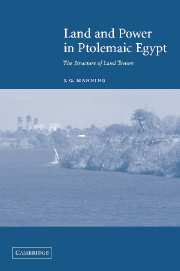Book contents
- Frontmatter
- Contents
- List of maps, figures and tables
- Preface
- Abbreviations
- Units of measure
- Maps
- Part I ISSUES AND HISTORICAL BACKGROUND
- Part II REGIONAL CASE STUDIES OF LAND TENURE
- Part III INTERPRETATION
- Chapter 5 The Ptolemaic state, the land tenure regime, and economic power
- Chapter 6 The private transmission of land
- Chapter 7 Conclusions
- Appendix 1 Translation of the Edfu donation text
- Appendix 2 Ptolemaic demotic land transfers from Upper Egypt
- Appendix 3 Translation of P. Amh. gr. 49
- List of references
- Index of sources
- General index
Chapter 6 - The private transmission of land
Published online by Cambridge University Press: 22 September 2009
- Frontmatter
- Contents
- List of maps, figures and tables
- Preface
- Abbreviations
- Units of measure
- Maps
- Part I ISSUES AND HISTORICAL BACKGROUND
- Part II REGIONAL CASE STUDIES OF LAND TENURE
- Part III INTERPRETATION
- Chapter 5 The Ptolemaic state, the land tenure regime, and economic power
- Chapter 6 The private transmission of land
- Chapter 7 Conclusions
- Appendix 1 Translation of the Edfu donation text
- Appendix 2 Ptolemaic demotic land transfers from Upper Egypt
- Appendix 3 Translation of P. Amh. gr. 49
- List of references
- Index of sources
- General index
Summary
Borrow money at interest and put it in farmland.
Instructions of Ankhsheshonqy (P. BM 10508, 16/x+9) [Lichtheim 1980: 172]Do not hand over your property to your younger brother and thereby make him act as your elder brother
Instructions of Ankhsheshonqy (P. BM 10508, 13/X+10) [Lichtheim 1980: 169]In this Chapter, I shift the focus from the institutions of the central state and its power, to the local organization of land tenure. I discuss the Egyptian tradition of property transmission, and the interaction of the Ptolemaic state to this ancient system. I will concentrate primarily on documents from the Thebaid, where the Egyptian material is at its fullest, and I will be concerned with two things: (1) the ancient institutions and social networks relating to land holding, and (2) the Egyptian tradition of property rights in land that were transferred by inheritance as well as by lease and sale contracts. In both cases, the documentary material shows that there was strong continuity with the pre-Ptolemaic period in the social and economic patterns of land tenure, and in the tradition of scribal practice with respect to contract-making. The Ptolemies did not alter the ancient property regime but, rather, established institutions designed to capture taxation revenue from production and from the circulation of property, and asserted the ancient pharaonic power of assigning rights to land.
- Type
- Chapter
- Information
- Land and Power in Ptolemaic EgyptThe Structure of Land Tenure, pp. 182 - 225Publisher: Cambridge University PressPrint publication year: 2003



